Muhammad Bilal Janjua
Simultaneous Intrusion Detection and Localization Using ISAC Network
May 12, 2025Abstract:The rapid increase in utilization of smart home technologies has introduced new paradigms to ensure the security and privacy of inhabitants. In this study, we propose a novel approach to detect and localize physical intrusions in indoor environments. The proposed method leverages signals from access points (APs) and an anchor node (AN) to achieve accurate intrusion detection and localization. We evaluate its performance through simulations under different intruder scenarios. The proposed method achieved a high accuracy of 92% for both intrusion detection and localization. Our simulations demonstrated a low false positive rate of less than 5% and a false negative rate of around 3%, highlighting the reliability of our approach in identifying security threats while minimizing unnecessary alerts. This performance underscores the effectiveness of integrating Wi-Fi sensing with advanced signal processing techniques for enhanced smart home security.
Interference Mitigation and Spectral Efficiency Enhancement in a Multi-BD Symbiotic Radio
Apr 09, 2025Abstract:This study presents a framework designed to mitigate direct-link interference (DLI) and inter-backscatter device interference (IBDI) in multi-backscatter orthogonal frequency division multiplexing (OFDM)-based symbiotic radio (SR) systems. The framework employs OFDM signal designs with strategic allocation of null subcarriers and incorporates two backscatter modulation techniques: on-off frequency shift keying (OFSK) and multiple frequency shift keying (MFSK) for symbiotic backscatter communication (SBC). Additionally, we propose Fully-Orthogonal and Semi-Orthogonal multiple access schemes to facilitate SBC alongside primary communication. The Fully-Orthogonal scheme maintains orthogonality between direct link and SBC signals, thereby ensuring interference-free SBC, albeit at a reduced spectral efficiency. In contrast, the Semi-Orthogonal schemes eliminate IBDI but permit partial DLI, striking a balance between reliability and spectral efficiency. To address the partial DLI inherent in Semi-Orthogonal schemes, successive interference cancellation (SIC) is employed at the receiver, enhancing SBC reliability. To tackle channel estimation challenges in SBC within the SR system, we implement non-coherent detection techniques at the receiver. The performance of the proposed system is evaluated based on average bit error rate (BER) and sum-rate metrics, demonstrating the effectiveness of our schemes. We provide analytical results for the system's detection performance under both proposed modulation techniques and multiple access schemes, which are subsequently validated through extensive simulations. These simulations indicate a notable error-rate reduction of up to $10^{-3}$ at $20$ dB with the Fully-Orthogonal scheme with MFSK.
Interference-Free Backscatter Communications for OFDM-Based Symbiotic Radio
Aug 17, 2024
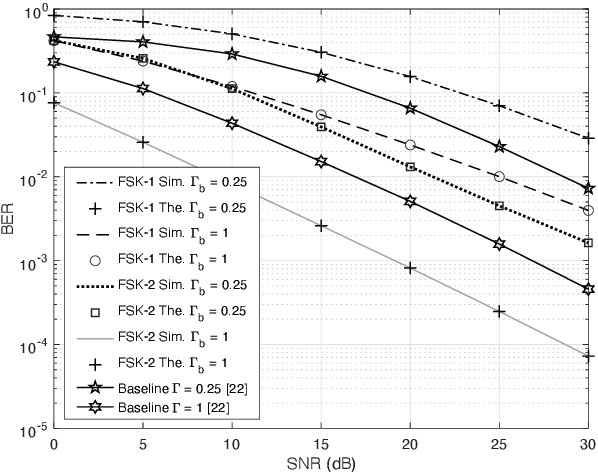
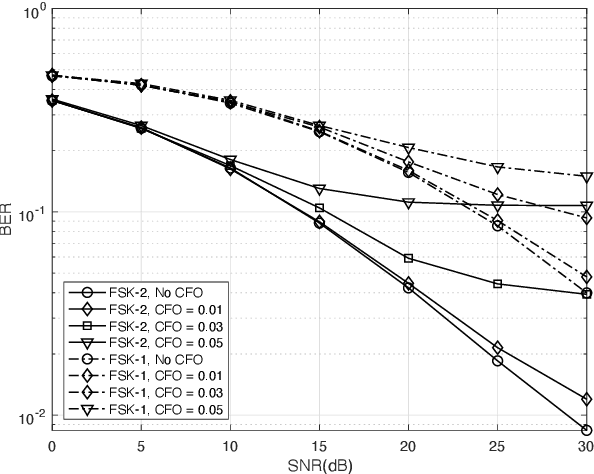
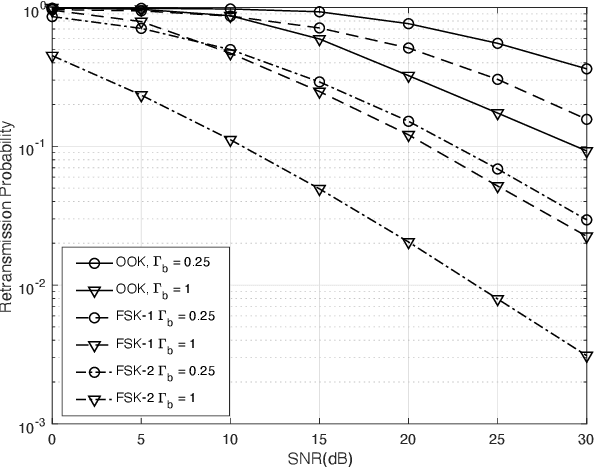
Abstract:This study proposes an orthogonal frequency division multiplexing (OFDM) based scheme to achieve interference-free backscatter communications (BC) in a symbiotic radio system. In specific, we propose three frequency shift keying (FSK) based backscatter modulation schemes to shift the primary signal, i.e., the OFDM symbols transmitted from a base station (BS), in the frequency domain to transmit its information. Symbiotically, the BS empties specific subcarriers within the band so that the received frequency-shifted signals from the backscatter device and the primary signal are always orthogonal. The first scheme relies on the combination of on-off keying (OOK) within the FSK modulation while the second and the third schemes are based on the conventional FSK modulation with different in-band null-subcarrier allocation. These schemes allow the use of non-coherent detection at the receiver which addresses the channel estimation challenge for the signals arriving from a backscatter device. We derive the bit-error rate performance of the detector theoretically. The comprehensive simulations show that the proposed approach achieves a lower bit-error rate up to 10-4 at 30 dB with BC by eliminating direct link interference.
Survey on Symbiotic Radio: A Paradigm Shift in Spectrum Sharing and Coexistence
Nov 17, 2021
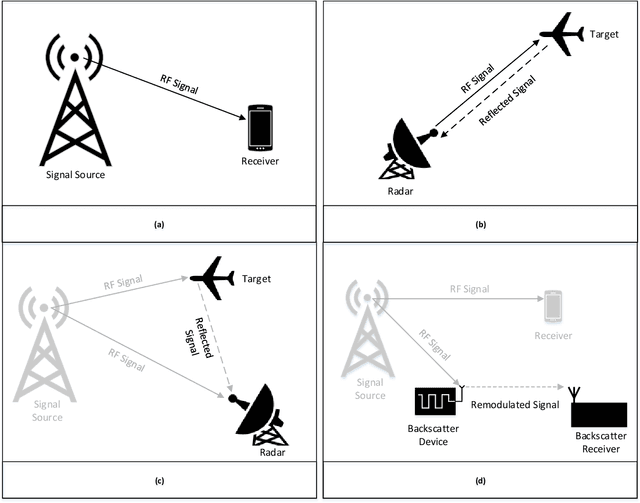
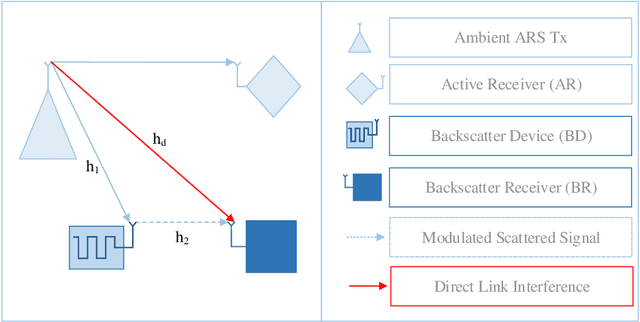
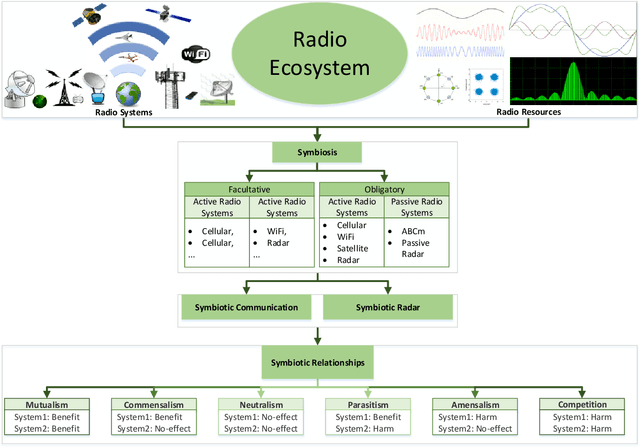
Abstract:Sixth-generation (6G) of mobile communication aims to connect this world digitally through green communication networks that provide secure, ubiquitous, and unlimited connectivity in an attempt to improve the overall quality of life.The driving force behind the development of these networks is the rapid evolution of Internet-of-Things (IoT), which has stimulated the proliferation of wireless applications in health,education, agriculture, utilities, etc. However, these applications are accompanied by the deployment of a massive number of IoT devices that require a significant radio spectrum for wireless connectivity. IoT devices usually have low data rate requirements and limited power provision but desirably a long life.Recently, the development of passive radio systems has opened new paradigms of spectrum sharing and coexistence. These systems utilize the radio resources and infrastructure of the active radio systems to perform their functionalities. By enabling the dependent coexistence, a new technology named symbiotic radio (SRad) enables the symbiotic relationships between the different radio systems ranging from mutual benefits or competition in terms of sharing the resources, in particular for IoT devices. This survey first provides the motivation for dependent coexistence and background of spectrum sharing through coexistence along with existing literature. Then, it describes the active and passive radio systems definition and a brief overview. Afterward, the history of symbiosis and the role of SRad technology in spectrum sharing and coexistence are defined while focusing on symbiotic communication. Lastly, we discuss research challenges, future directions, and applications scenarios.
 Add to Chrome
Add to Chrome Add to Firefox
Add to Firefox Add to Edge
Add to Edge